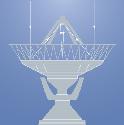
 From Astronomy Encyclopedia
From Astronomy Encyclopedia From Astronomy Encyclopedia
From Astronomy Encyclopedia Study of celestial bodies by means of the electromagnetic radio frequency waves they emit and absorb naturally.
Study of celestial bodies by means of the electromagnetic radio frequency waves they emit and absorb naturally.

U.S. physicist and mathematician, born in Germany. He formulated the special theory of relativity (1905) and the general theory of relativity (1916), and made major contributions to the quantum theory, for which he was awarded the Nobel prize for physics in 1921. He was noted also for his work for world peace.

Russian-born US physicist who provided the first evidence for the Big Bang theory of the origin of the universe. He predicted that it would have produced a background of microwave radiation, which was later found to exist.

Austrian-born astronomer, working in England and the U.S.: with Bondi and Hoyle he proposed the steady-state theory of the universe.

US astronomer. He made pioneer studies of the Sun and founded three major observatories. In 1889 he invented the spectroheliograph, a device for photographing the Sun at particular wavelengths.

British theoretical physicist noted for his research into the origin of the universe. His work influenced the development of the big bang and black hole theories.

Danish astronomer: he discovered the existence of giant and dwarf stars, originating one form of the Hertzsprung-Russell diagram.

American astronomer who proved that the spiral ‘nebulae’ were galaxies lying far beyond our own Milky Way.

From <i>The Hutchinson Unabridged Encyclopedia</i>
Belgian cosmologist who - perhaps because he was also a priest - was fascinated by the Creation, the beginning of the universe, for which he devised what later became known as the ‘Big Bang’ theory.

US astronomer and popularizer of astronomy whose main research was on planetary atmospheres, including that of the primordial Earth.

Schwarzschild became interested in astronomy as a schoolboy and published papers on binary orbits at 16. He became director of the Potsdam observatory in 1909. Although an excellent observational astronomer who made great advances in photographic methods, Schwarzschild’s lasting contributions are theoretical and were largely made during the last year of his life.

From <i>The Hutchinson Unabridged Encyclopedia</i>
Dutch astronomer, mathematician, and physicist. He contributed to the birth of modern cosmology and was influential in English-speaking countries in bringing the relevance of the general theory of relativity to the attention of astronomers.

U.S. astronomer, born in Russia, noted for his work in stellar spectroscopy and his discovery (1937) of interstellar hydrogen.
U.S. physicist and mathematician, born in Germany. He formulated the special theory of relativity (1905) and the general theory of relativity (1916), and made major contributions to the quantum theory, for which he was awarded the Nobel prize for physics in 1921. He was noted also for his work for world peace.
Russian-born US physicist who provided the first evidence for the Big Bang theory of the origin of the universe. He predicted that it would have produced a background of microwave radiation, which was later found to exist.
Austrian-born astronomer, working in England and the U.S.: with Bondi and Hoyle he proposed the steady-state theory of the universe.
US astronomer. He made pioneer studies of the Sun and founded three major observatories. In 1889 he invented the spectroheliograph, a device for photographing the Sun at particular wavelengths.
British theoretical physicist noted for his research into the origin of the universe. His work influenced the development of the big bang and black hole theories.
Danish astronomer: he discovered the existence of giant and dwarf stars, originating one form of the Hertzsprung-Russell diagram.
American astronomer who proved that the spiral ‘nebulae’ were galaxies lying far beyond our own Milky Way.
From The Hutchinson Unabridged Encyclopedia
Belgian cosmologist who - perhaps because he was also a priest - was fascinated by the Creation, the beginning of the universe, for which he devised what later became known as the ‘Big Bang’ theory.
US astronomer and popularizer of astronomy whose main research was on planetary atmospheres, including that of the primordial Earth.
Schwarzschild became interested in astronomy as a schoolboy and published papers on binary orbits at 16. He became director of the Potsdam observatory in 1909. Although an excellent observational astronomer who made great advances in photographic methods, Schwarzschild’s lasting contributions are theoretical and were largely made during the last year of his life.
From The Hutchinson Unabridged Encyclopedia
Dutch astronomer, mathematician, and physicist. He contributed to the birth of modern cosmology and was influential in English-speaking countries in bringing the relevance of the general theory of relativity to the attention of astronomers.
U.S. astronomer, born in Russia, noted for his work in stellar spectroscopy and his discovery (1937) of interstellar hydrogen.